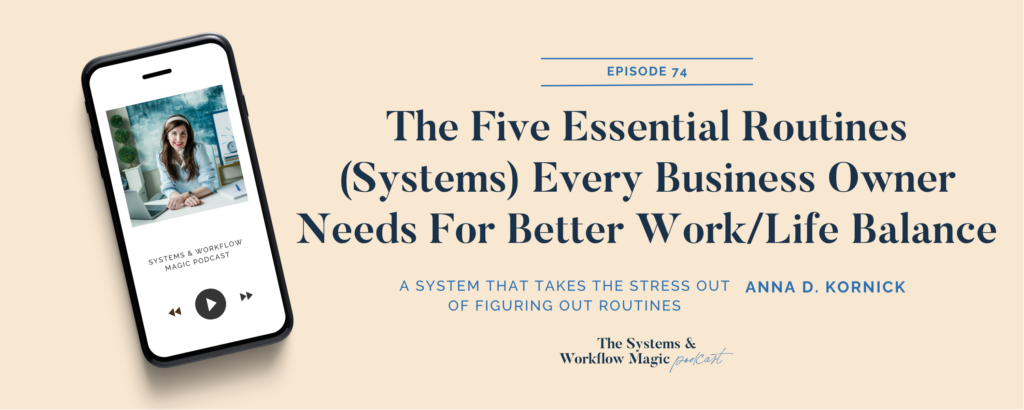What if a few simple tweaks to your daily routines could help you become the best version of you?
Over the years, I’ve found there are 5 daily routines that help us show up as our best selves: as business owners, as parents, and as human beings. Those 5 routines are:

- your morning routine
- your evening routine
- your workday startup routine
- your workday shutdown routine
- your weekly planning session
These serve as the cornerstones of your days and weeks that help us feel safe and secure, and help us transition smoothly into different parts of our days. I walked through each of these daily routines with Dolly DeLong on the Systems & Workflow Magic Podcast, what they can look like, and how you can create realistic daily routines for yourself that you can actually stick to.
Read on for the details, or listen to the full episode here.
Morning Routine
Your morning routine is a series of steps in your daily routine that takes you from sleeping to starting your day – whatever that looks like for you! It’s your go-time. That might be sitting down at your desk to start your work day, walking into your office, or dropping your kids off at school. We’re all different, so your go-time might look different from someone else’s.
A morning routine will have things you need to do, like eating breakfast, taking a shower, and getting the kids ready – as well as things you want to do, like meditation, working out, or prayer. There’s no one right way to do a morning routine – it’s personal to you.

Evening Routine
The purpose of an evening routine is to help prepare your body for quality sleep – because you need 7-9 hours each night! Truly, sleep is one of the most underrated time management strategies there is.
An evening routine could include a skincare routine, having a set time to turn off your screens, taking a long hot bath – whatever it is, it should help you feel ready to get a good night’s rest.
Workday Startup Routine
This is kind of like the morning routine for the workday. The startup routine is a series of steps that helps you transition from not-work brain, to work brain. It helps you switch off your personal thoughts (as much as you can!) and get into a state of focus on your work. Because let’s be real – multitasking does not work.
Having a routine as simple as sitting down at your desk, opening your laptop, opening your task management system, and identifying your top three priorities for the day… can change your day. When you do these same steps in the same order every single day, it trains your brain to associate those physical activities with a mental state of being.
Workday Shutdown Routine
Just like your workday startup routine, your workday shutdown routine is meant to help your transition your mindset. Shutdown takes you from work brain to not-work brain. The workday shutdown routine will help you step into your downtime being present and attentive to your family. You will leave work at work – even if “work” is in your home office. The shutdown routine is your virtual commute!
Plus, let’s be honest. We won’t finish every single project every day. The workday shutdown routine will also help you shut off your brain when you leave tasks incomplete. Our brains prefer things that are unfinished – so we tend to recycle thoughts about things we still need to do. This is so common it actually has a name (the Zeigarnik Effect!). The workday shutdown routine will help you combat the Zeigarnik Effect and trick your brain into thinking you’re done for the day.
One of my favorite examples of a shutdown routine comes from Mr. Roger’s Neighborhood. Whenever Mr. Rogers would come from to begin each episode, he would take off his outside jacket and put on a cozy cardigan. He’d take off his outside shoes and put on his inside shoes. Mr. Rogers was performing a series of physical steps that helped him transition from outside brain to inside brain… that’s a shutdown routine!
Weekly Planning Session
This is a time you set aside each week to get a bird’s eye view of the week ahead. You use this time to identify any potential roadblocks in the week ahead and come up with potential solutions, before they happen.
This is your chance to step into your week calm and prepared. Weekly planning sessions are a chance to make decisions ahead of time (and avoid decision fatigue) so we can stay fresh throughout the week.
A weekly planning session could include everything from:
- Planning your week
- Identifying your time blocks
- Planning your meals
- Putting in your grocery order
- Identifying who is picking up the kids from school each day
- And more!
How to create a daily routine
Maybe you’re thinking, “Okay Anna, these routines sound great, but how do I actually make it happen?” This is where we need to get really clear about a routine needs to have, versus what we want it to have.
Needs vs. Wants
Think about one of these routines you want to start. Let’s say you want to create a smoother morning routine. Start by making a list of the things you need to do during that routine in order for it to be successful. This is the bare minimum that has to happen for this routine. For a morning routine, you know you need to brush your teeth, get dressed, get your kids dressed and fed if applicable, and pack your bag.
Now, think about what you want to do in this routine. Do you want to do yoga? Meditate? Read your bible and have prayer time? Go for a walk? Decide what you want to incorporate into your routine.
Once you’ve got your list of needs and wants, you need to make sure to keep them separate. If you’re writing this out, separate them out into two different columns. One of the biggest mistakes on routines is we focus too much on the things we want to do, and we end up missing the things we need to do.

Putting daily routines into practice
Now that we have our list, we need to put them in order. Think about what order makes the most sense based on the physical flow of your space. Your morning routine needs to take you from your bed to the door (or your home office desk). So, you’ll want to design your morning routine to take you directly from point A to point B, instead of zigzagging around the house.
Once you’ve gotten your order, put time estimates next to each activity! Decide when you want to end your routine first, and work backwards to label time estimates next to each step. Remember to estimate more time than you think you need for each activity to combat the planning fallacy, because that’s probably how it will shake out in the end anyway.
When you’re finished, you’ll have your routine start time. You might realize that your start time is great – or you might realize that your routine is too long, and you need to do some editing. Where can you cut the routine down? What can you move to other parts of the week? Work to simplify your routines as much as possible, so they’re realistic!
Now that you’ve got a realistic daily routine, you’re going to make it visible. Take your routine and stick it on a clipboard. It’s unfair to assume you’ll get this routine right the first time you try it. Make it easy on yourself by displaying it. Visualize yourself walking through your routine before you even start it… so you’re that much more likely to be successful (it’s what Michael Phelps does before a meet!).
And then the last step? Get started! Try it out, and change it when you need to change it. Life is full of ebbs and flows, and it’s normal to change your routines as life changes.
Need a textbook for time management?
Time Management Essentials: The Tools You Need to Maximize Your Attention, Energy, and Productivity is my textbook for managing time with purpose. In this book, I’ve included everything someone would need to know to be successful with time management, including:
- how to define your personal vision
- how to define your core values (and incorporate them in your calendar)
- how to get organized with a time management system
- how to get energized
- how to get enough rest (the most underrated productivity tool there is!)
Visit https://annadkornick.com/book to preorder today!
Want more tips like this? Listen to the full episode here, or find out more about Dolly here.
Be the first to comment